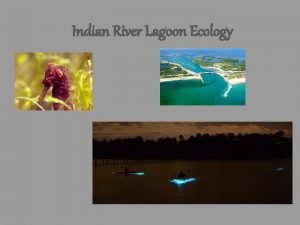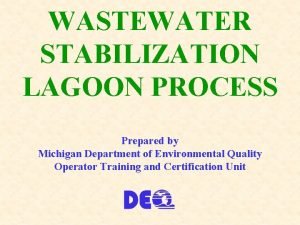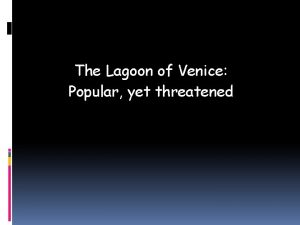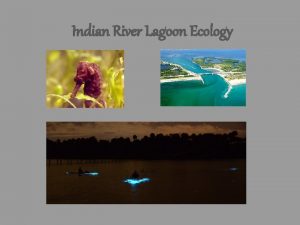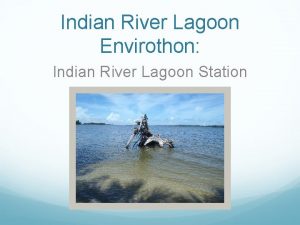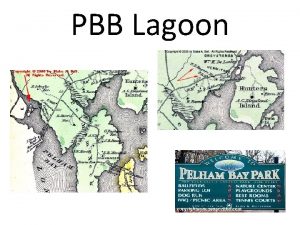Venice images 2 illustrating the lagoon environment and












- Slides: 12

Venice images 2, illustrating the lagoon environment and its relation to the historic city lesson 2: the physical environment and flooding View of Torcello © David Anderson

General characteristics of coastal lagoons • Coastal lagoons are shallow bodies of water sheltered from the open sea by barrier beaches, islands, or reefs. • They form along low gradient coastlines and are typically brackish due to mixing between sea water and fresh water from streams. • On geological timescales they are short-lived systems that respond dynamically to sea level changes and changes in sediment inputs/outputs from terrestrial and marine processes. • They are usually connected to the open sea by passages (inlets) between barrier islands.

General characteristics of coastal lagoons This image shows general features found in coastal lagoons. Coastal lagoons extend along about 15% of the world’s coastline. http: //www. ecologyandsociety. org/vol 14/iss 1/art 8/figure 1. html

Landsat 7 image of the Lagoon of Venice Note three inlets to the lagoon and the jetties which deepen and stabilise each inlet to keep them navigable. Lagoon of Venice © Wikimedia Commons

Image showing the historic city, the northern part of the lagoon, and the Lido inlet © Google Maps • The average depth of the lagoon is only about 1 metre. Natural channels deeper than this criss-cross its bed, circulating water and sediment. Artificial navigation channels have been dug into the lagoon bed, some as much as 20 metres deep.

Features of the Lagoon of Venice • BarenaSaltmarsh islet: flat and silty emerged part of the saltmarshes covered by halophytic plants which are only submerged during the highest spring tides. • VelmaMudflat: shallow lagoon area characterised by soft soil which only emerge during low tides. • ChiaroSalt pan: small depressions in the saltmarsh where brackish water trapped during high tides mixes with rainwater to form a pond • GheboTidal creek: small and inning canal flowing through the saltmarsh connecting its inner parts with the deeper lagoon canals Mudflat © Patrick Fitzgerald, Wikimedia Commons Tidal Creek © Oliver Dixon, Wikimedia Commons

Background on the Lagoon of Venice • The lagoon is about 50 km long and 20 km wide (approx. 550 km 2). • Its outer limits are the river mouths of the Sile to the north and the Brenta to the south, and it is separated physically from the sea by the islands and peninsulae of Jesolo, Cavallino-Treporti, Lido di Venezia, Pellestrina and Sottomarina which stretch for about 50 km. • It is fed by small rivers, and the lagoon is influenced by high and low tides (with a tidal range of about 120 cm). • The island of Venice marks the conventional boundary between the northern lagoon (formed by a group of islands like Burano and Torcello) and the southern lagoon (with Pellestrina and Chioggia). • Lagoon canals facilitate the exchange between the lagoon and the sea, guaranteeing water renewal. The principal canals join the three harbour entrances (Lido, Malamocco and Chioggia). • Patches of marshland cover most of the mainland edges of the lagoon, especially in the northern part and in the area of fish farms in the centre and in the south. • 60% of the lagoon is permanently under water, 25% is regularly inundated and exposed by changing tides, and the rest consists of islands.

Construction of Venice Aerial view of Venice © Wikimedia Commons • • Venice started in the 5 th century and over centuries an original cluster of over 100 islands was gradually built on and connected together. The lagoon was valuable for its natural resources, for defence, and for access to trade routes. By the 14 th century Venice was a major Mediterranean trading and military power. During the 15 th to 17 th centuries, the Venetians diverted seven rivers north and south of the lagoon to reduce sediment input which would otherwise have cut Venice off from the sea.

Construction of Venice Wooden piles © Wikimedia Commons • From the 9 th century onwards, Venetians built up their city by driving millions of wooden piles into the soft, marshland sediment to provide a foundation for the buildings. • An impermeable type of marble called Istrian stone was then placed on top of the wooden foundation to act as a base and protective layer between the wet material beneath and the masonry above.

Coastal flooding • Coastal flooding is a phenomenon distinct from other forms of flooding. • Coastal flooding is typically multi-causal often involving a combination of: – Unusually high tides (spring tides) – River flooding – Storm surge • In Venice this type of flooding is called acqua alta (high water).

Reasons for vulnerability of Venice to coastal flooding Adriatic Sea © Wikimedia Commons • The position of Venice at the northern end of the Adriatic Sea means that when the Sirocco wind blows from the southeast, surface water is pushed towards the Venice lagoon. • Strong winter storms combined with low atmospheric pressure, high tide, and heavy rainfall can lead to exceptionally high water levels that can flood large areas of the historic city and other islands in the lagoon. November 4 th 1966 Most devastating storm surge with water levels nearly 2 metres higher than normal – city badly flooded and agriculture destroyed on other lagoon islands http: //www. weatheronline. co. uk/reports/wind/The-Sirocco. htm

Reasons for vulnerability of Venice to coastal flooding • Acqua alta has become more frequent in Venice because the city’s ground level has dropped relative to average sea level by about 30 cm since a fixed reference point was established at Punta della Salute (entry to the Grand Canal) in 1897. • This is due to both ground subsidence and sea level rise. • Some of this subsidence (about 12 cm) was caused by 20 th century pumping of water from deep aquifers beneath the lagoon for industry at Marghera (banned since 1970 s). • Natural subsidence continues (0. 5 mm a year), and the Mediterranean sea level is continuing to rise (over 1 mm a year).


